- الرئيسية
- معلومات عنا
- صناعة
- الخدمات
- قراءة
- اتصل بنا
سوق معدات التدريب الرياضي: التحليل الحالي والتوقعات (2023-2030)
التركيز على النوع (معدات تدريب القلب والأوعية الدموية، معدات تدريب القوة، آلات أخرى)؛ الجنس (ذكر، أنثى)؛ نوع المشتري (أفراد، مؤسسات وغيرها)؛ قناة التوزيع (متاجر البيع بالتجزئة، متاجر متخصصة ورياضية، عبر الإنترنت، أخرى) والمنطقة/الدولة
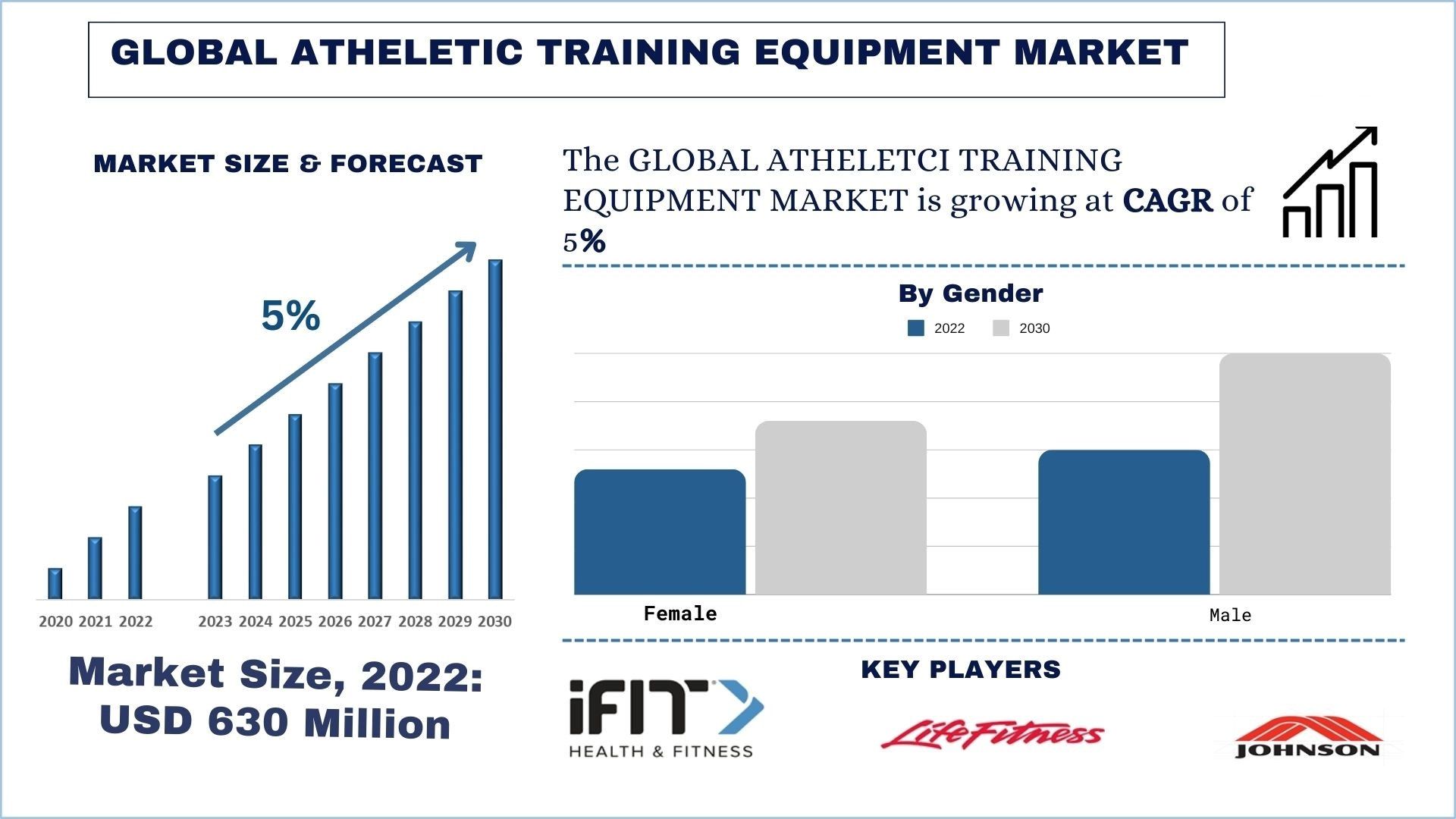
حجم سوق معدات التدريب الرياضي والتوقعات (2023-2030)
من المتوقع أن يسجل سوق معدات التدريب الرياضي معدل نمو سنوي مركب يبلغ تقريبًا 5% خلال الفترة من 2023 إلى 2030.
تحليل سوق معدات التدريب الرياضي
معدات التدريب الرياضي هي أي آلة أو جهاز مطلوب لممارسة الرياضة البدنية لإدارة الوزن الكلي وتحسين القدرة البدنية وتنمية القوة العضلية. ازداد الطلب على سوق معدات اللياقة البدنية عالميًا، بسبب الشعبية المتزايدة للأحداث الوطنية والدولية الكبرى مثل كأس العالم لكرة القدم والألعاب الأولمبية وكأس العالم للكريكيت، مما يدفع سوق المعدات الرياضية إلى الأمام. إن الارتفاع في المشكلات الصحية المرتبطة بنمط الحياة، مثل الإجهاد والسمنة، يحفز المزيد من الأفراد على المشاركة في الأنشطة الخارجية وأنشطة اللياقة البدنية، مما يؤدي إلى زيادة في الطلب على مجموعة واسعة من معدات اللياقة البدنية والرياضة. الفوائد الصحية الإيجابية للرياضة تكتسب اعترافًا أوسع. توفر المشاركة في الرياضة العديد من المزايا للجسم البشري، بما في ذلك القدرة على حرق الدهون والحفاظ على وزن صحي للجسم. وبالتالي، فإن المزيد من الأشخاص يمارسون الرياضة لتعزيز لياقتهم البدنية ورفاهيتهم. علاوة على ذلك، فإن الانتشار المتزايد للأحداث الرياضية الوطنية والدولية يدفع طلب المستهلكين على السلع الرياضية، مما يؤدي إلى توسع السوق. وعلى العكس من ذلك، فإن الشعبية المتزايدة للأنشطة الداخلية مثل ألعاب الفيديو وألعاب الطاولة وألعاب الهاتف المحمول تحد من نمو سوق المعدات الرياضية. ومع قضاء الشباب والأطفال وقتًا مفرطًا على أجهزتهم المحمولة ونادرًا ما يشاركون في الرياضات الخارجية، فإن الانتشار السريع للإنترنت له تأثير سلبي على نمو السوق. على سبيل المثال، في عام 2022، افتتحت PUMA أول متجر لها في جمهورية المالديف، وهي بقعة جذب سياحي شهيرة شهدت زيادة ثلاثية في عدد السياح الوافدين على مدى العامين الماضيين. تقف جزر المالديف الآن في المرتبة العشرين كسوق لتكون جزءًا من شبكة PUMA India، إلى جانب دول مثل سنغافورة وإندونيسيا وماليزيا وتايلاند وفيتنام والفلبين.
تعد Nautilus, Inc.؛ Torque Fitness؛ iFIT Inc.؛ KETTLER Sport؛ Life Fitness؛ Peloton؛ TRUE؛ Technogym S.P.A؛ Johnson Health Tech؛ HOIST Fitness Systems بعضًا من اللاعبين الرئيسيين في السوق. تم إجراء العديد من عمليات الاندماج والاستحواذ جنبًا إلى جنب مع الشراكات من قبل هؤلاء اللاعبين لتسهيل حصول العملاء على منتجات/تقنيات مبتكرة وعالية التقنية.
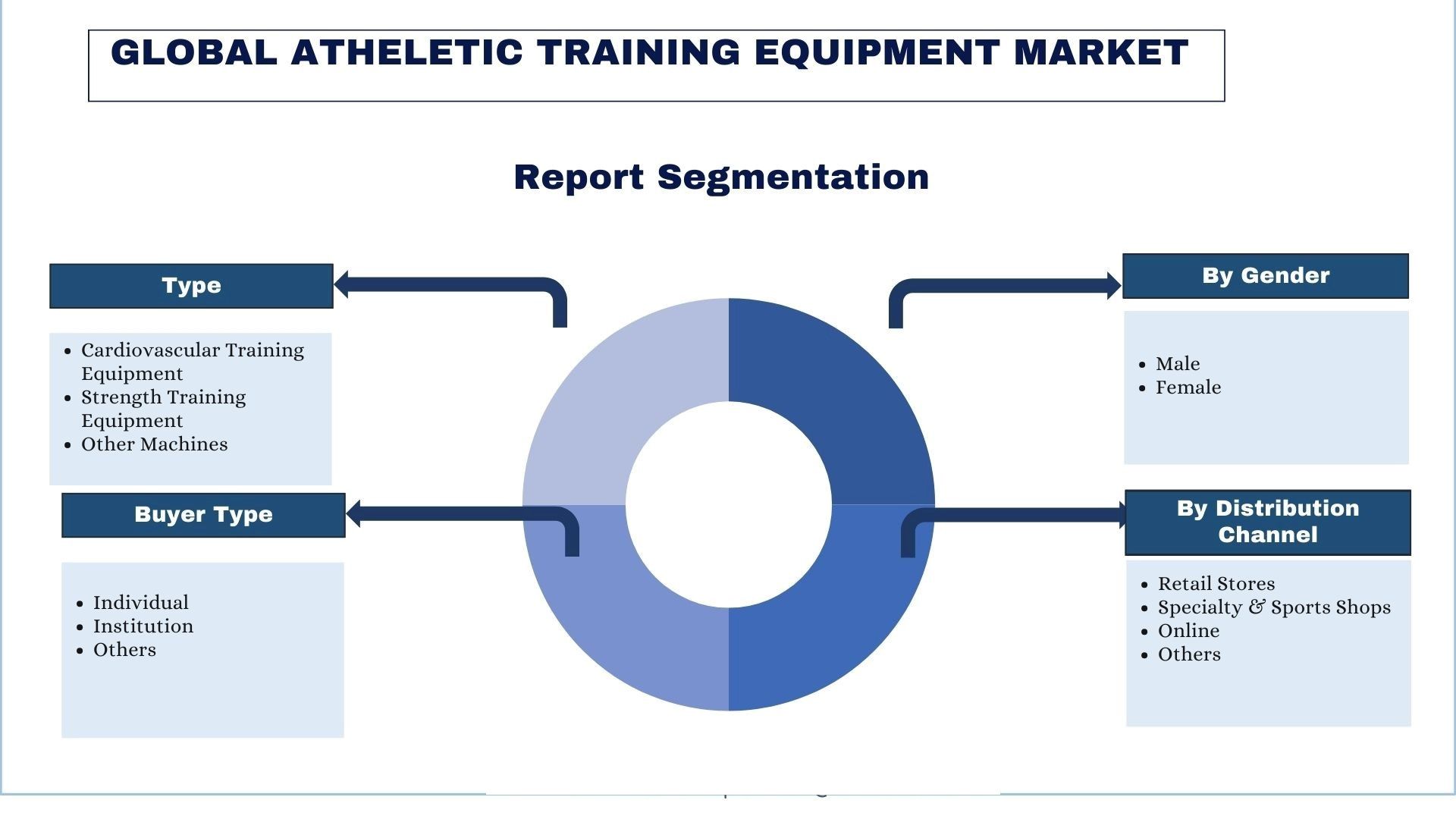
اتجاهات سوق معدات التدريب الرياضي
"من بين الأنواع، استحوذت فئة معدات التدريب على القلب والأوعية الدموية على حصة كبيرة في السوق في عام 2022"
استنادًا إلى النوع، يتم تقسيم سوق معدات التدريب الرياضي إلى معدات التدريب على القلب والأوعية الدموية ومعدات تدريب القوة والآلات الأخرى. استحوذ قطاع معدات التدريب على القلب والأوعية الدموية على حصة كبيرة في السوق ويقدر أنه سينمو بسرعة خلال الإطار الزمني المتوقع بسبب زيادة انتشار أمراض القلب والأوعية الدموية، فضلاً عن زيادة وعي الناس بلياقتهم البدنية. يعد تطوير المعدات المبتكرة وسهلة الاستخدام نتيجة للتقدم التقني، مما يؤدي إلى النمو في السوق.
"من بين الجنسين، من المتوقع أن يشهد قطاع الذكور معدل نمو سنوي مركب كبير خلال الفترة المتوقعة"
استنادًا إلى الجنس، يتم تقسيم السوق إلى ذكور وإناث. استحوذ قطاع الذكور على حصة سوقية كبيرة، ومن المتوقع أن ينمو بمعدل نمو سنوي مركب كبير خلال الفترة المتوقعة بسبب الزيادة في مشاركة الذكور في مختلف الرياضات وهي العامل الرئيسي الذي يدفع السوق إلى الأمام. ومن المتوقع أن يؤثر الاعتراف المتزايد بالأنشطة البدنية لصحة الفرد بشكل إيجابي على توسع السوق. علاوة على ذلك، من المتوقع أن يؤدي الارتفاع في شهرة الأحداث الرياضية مثل كأس العالم FIFA والألعاب الأولمبية وكأس العالم للكريكيت ICC والكابادي إلى زيادة نمو السوق خلال الفترة المتوقعة. إن الوعي المتزايد بنمط حياة صحي والارتفاع الناتج في شعبية الأنشطة الرياضية المتنوعة سيؤدي إلى زيادة نمو السوق.
"من بين أنواع المشترين، من المتوقع أن يشهد قطاع الأفراد معدل نمو سنوي مركب كبير خلال الفترة المتوقعة"
استنادًا إلى نوع المشتري، يتم تقسيم السوق إلى أفراد ومؤسسات وغيرهم. استحوذ قطاع الأفراد على حصة سوقية كبيرة، ومن المتوقع أن ينمو بمعدل نمو سنوي مركب كبير خلال الفترة المتوقعة حيث يبحث الأفراد حاليًا عن طرق لدمج التدريب في روتينهم اليومي، مما يدفع الحاجة إلى معدات التدريب الرياضي.
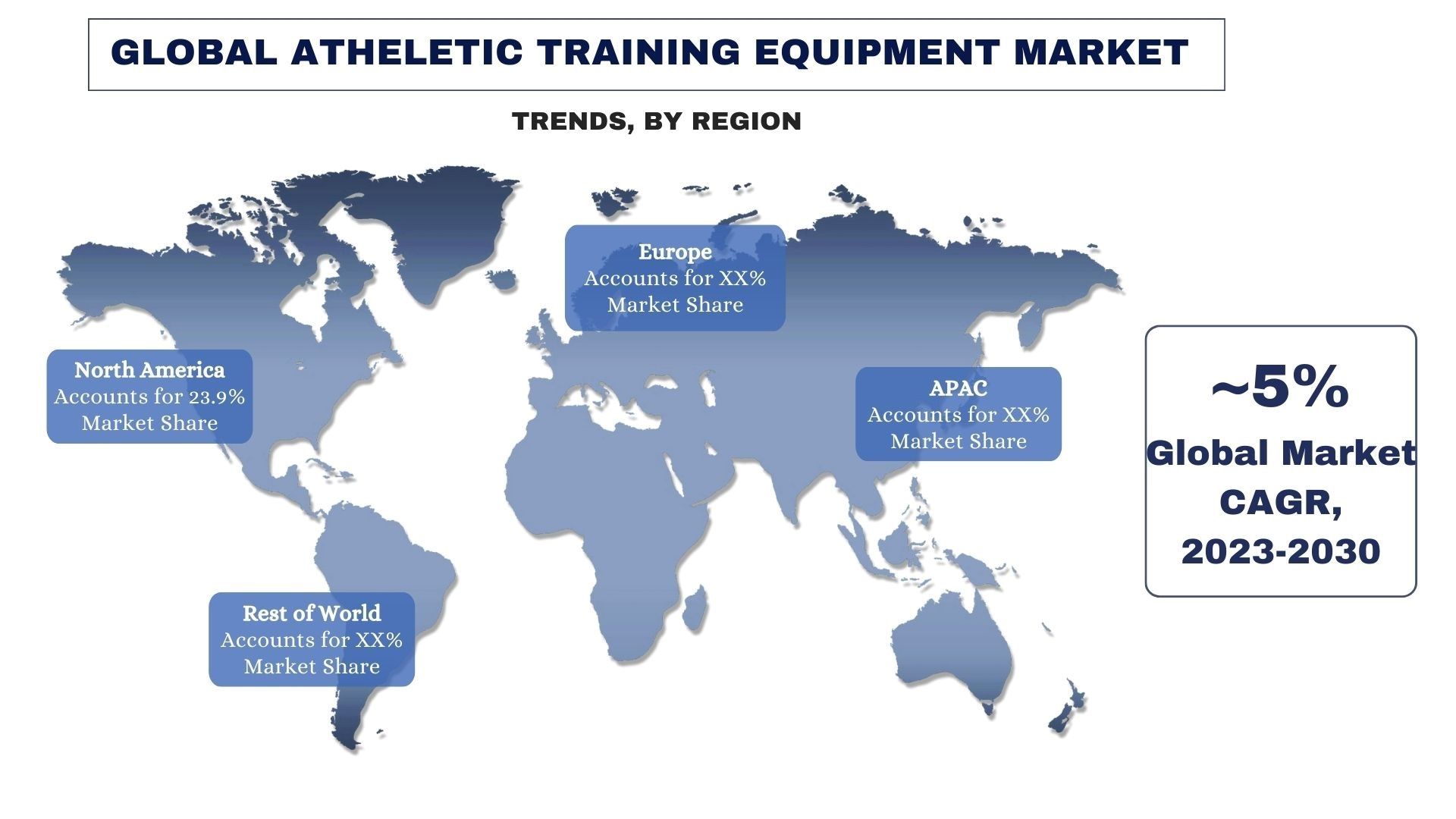
"من بين قنوات التوزيع، من المتوقع أن يشهد متجر البيع بالتجزئة معدل نمو سنوي مركب كبير خلال الفترة المتوقعة"
استنادًا إلى قناة التوزيع، يتم تقسيم السوق إلى متاجر البيع بالتجزئة ومتاجر متخصصة ورياضية وعبر الإنترنت وغيرها. استحوذ قطاع متاجر البيع بالتجزئة على حصة سوقية كبيرة، ومن المتوقع أن ينمو بمعدل نمو سنوي مركب كبير خلال الفترة المتوقعة. من المتوقع أن تكون قناة التوزيع بالتجزئة للمعدات الرياضية هي الأسرع نموًا خلال الفترة المتوقعة نظرًا للشعبية المتزايدة واعتماد الجيل X وجيل الألفية والجيل Z على الإنترنت ومنصة التجارة الإلكترونية. يفضل المستهلكون البوابات الإلكترونية والمواقع الرسمية لشراء المنتجات المتميزة من أجل الحصول على خدمات ذات قيمة مضافة بما في ذلك سياسات الإرجاع المريحة والدفع نقدًا عند التسليم وخدمات العملاء المتكاملة والمركّزة.
"من المتوقع أن تشهد أمريكا الشمالية نموًا كبيرًا خلال الفترة المتوقعة"
تشكل أمريكا الشمالية سوقًا رئيسيًا لصناعة معدات التدريب الرياضي نظرًا للشعبية المتزايدة للألعاب مثل كرة القدم وكرة السلة وما إلى ذلك، مما يدفع الحكومة في المنطقة إلى إنشاء ساحات وتقديم تجربة رياضية محسنة للمواطنين. ومن المتوقع أن يخلق هذا نظرة مستقبلية إيجابية لسوق نمو السوق خلال الفترة المتوقعة. علاوة على ذلك، تؤدي القاعدة الأكبر من السكان الذين يعانون من السمنة المفرطة في المنطقة إلى زيادة اعتماد معدات اللياقة البدنية. للسمنة آثار سلبية طويلة المدى على الصحة بما في ذلك على سبيل المثال لا الحصر أمراض القلب والسكتة الدماغية والسكري من النوع الثاني وارتفاع ضغط الدم والسرطان وأمراض العظام والمفاصل الأخرى. في عام 2014، وفقًا لتحليل أجراه المركز الوطني للوزن والعافية، بلغت التكلفة السنوية للسمنة 305 مليارات دولار، والتي شملت الخدمات الطبية المباشرة وغير الطبية، وخسائر إنتاجية العمال، وقضايا الإعاقة، والوفاة المبكرة. وقد أدى ذلك إلى زيادة الحاجة إلى إدارة الوزن في المنطقة.
تغطية تقرير سوق معدات التدريب الرياضي
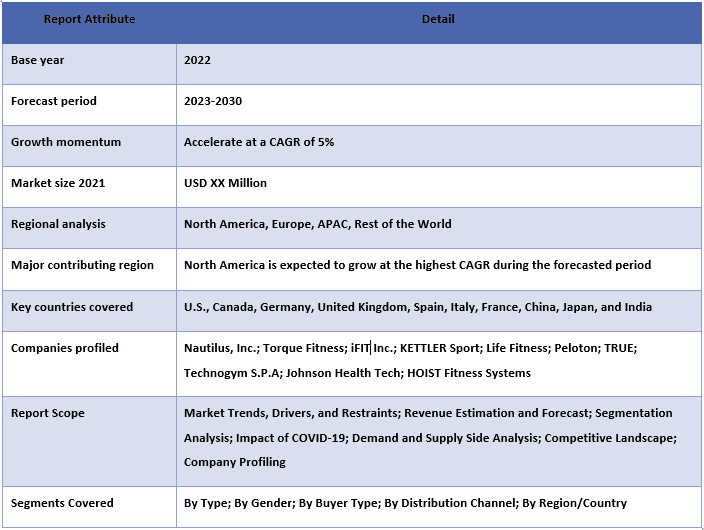
أسباب شراء هذا التقرير:
- تتضمن الدراسة تحليل تقدير حجم السوق والتوقعات الذي تم التحقق منه من قبل خبراء الصناعة الرئيسيين الموثوقين.
- يقدم التقرير مراجعة سريعة للأداء العام للصناعة في لمحة واحدة.
- يغطي التقرير تحليلاً متعمقًا لأقران الصناعة البارزين مع التركيز الأساسي على البيانات المالية التجارية الرئيسية ومجموعة المنتجات واستراتيجيات التوسع والتطورات الأخيرة.
- دراسة تفصيلية للمحركات والقيود والاتجاهات الرئيسية والفرص السائدة في الصناعة.
- تغطي الدراسة بشكل شامل السوق عبر قطاعات مختلفة.
- تحليل متعمق على المستوى الإقليمي للصناعة.
خيارات التخصيص:
يمكن تخصيص سوق معدات التدريب الرياضي العالمي بشكل أكبر وفقًا للمتطلبات أو أي قطاع سوق آخر. إلى جانب ذلك، تتفهم UMI أن لديك احتياجات عملك الخاصة، لذا لا تتردد في التواصل معنا للحصول على تقرير يناسب متطلباتك تمامًا.
جدول المحتويات
منهجية البحث لتحليل سوق معدات التدريب الرياضي العالمي (2023-2030)
كان تحليل السوق التاريخي، وتقدير السوق الحالي، والتنبؤ بالسوق المستقبلي لسوق معدات التدريب الرياضي العالمي هي الخطوات الرئيسية الثلاث التي تم اتخاذها لإنشاء وتحليل تبني معدات التدريب الرياضي في المناطق الرئيسية على مستوى العالم. تم إجراء بحث ثانوي شامل لجمع أرقام السوق التاريخية وتقدير حجم السوق الحالي. ثانيًا، للتحقق من صحة هذه الرؤى، تم أخذ العديد من النتائج والافتراضات في الاعتبار. علاوة على ذلك، تم أيضًا إجراء مقابلات أولية شاملة مع خبراء الصناعة عبر سلسلة القيمة لسوق معدات التدريب الرياضي العالمي. بعد افتراض أرقام السوق والتحقق من صحتها من خلال المقابلات الأولية، استخدمنا منهجًا تصاعديًا / تنازليًا للتنبؤ بحجم السوق الكامل. بعد ذلك، تم اعتماد طرق تقسيم السوق وتثليث البيانات لتقدير وتحليل حجم سوق القطاعات والقطاعات الفرعية للصناعة ذات الصلة. تم شرح المنهجية التفصيلية أدناه:
تحليل حجم السوق التاريخي
الخطوة 1: دراسة متعمقة للمصادر الثانوية:
تم إجراء دراسة ثانوية مفصلة للحصول على حجم السوق التاريخي لسوق معدات التدريب الرياضي من خلال مصادر الشركة الداخلية مثل التقرير السنوي والبيانات المالية، وعروض الأداء، والنشرات الصحفية، وما إلى ذلك، ومصادر خارجية بما في ذلك المجلات والأخبار والمقالات والمنشورات الحكومية ومنشورات المنافسين وتقارير القطاعات وقاعدة بيانات الطرف الثالث والمنشورات الموثوقة الأخرى.
الخطوة 2: تجزئة السوق:
بعد الحصول على حجم السوق التاريخي لسوق معدات التدريب الرياضي، أجرينا تحليلًا ثانويًا مفصلاً لجمع رؤى السوق التاريخية وحصتها للقطاعات والقطاعات الفرعية المختلفة للمناطق الرئيسية. تضمنت القطاعات الرئيسية المدرجة في التقرير النوع والجنس ونوع المشتري وقناة التوزيع. تم إجراء المزيد من التحليلات على مستوى الدولة لتقييم التبني العام لنماذج الاختبار في تلك المنطقة.
الخطوة 3: تحليل العوامل:
بعد الحصول على حجم السوق التاريخي للقطاعات والقطاعات الفرعية المختلفة، أجرينا تحليلًا تفصيليًا للعوامل لتقدير حجم السوق الحالي لسوق معدات التدريب الرياضي. علاوة على ذلك، أجرينا تحليلًا للعوامل باستخدام متغيرات تابعة ومستقلة مثل الزيادة في انتشار السمنة والارتفاع في الوعي الصحي وما إلى ذلك على مستوى العالم. تم إجراء تحليل شامل لسيناريوهات جانب الطلب والعرض مع الأخذ في الاعتبار الشراكات وعمليات الاندماج والاستحواذ والتوسع التجاري وإطلاق المنتجات في قطاع سوق معدات التدريب الرياضي في جميع أنحاء العالم.
تقدير حجم السوق الحالي والتنبؤ به
تحديد حجم السوق الحالي: بناءً على رؤى قابلة للتنفيذ من الخطوات الثلاث المذكورة أعلاه، توصلنا إلى حجم السوق الحالي واللاعبين الرئيسيين في سوق معدات التدريب الرياضي العالمي وحصص السوق للقطاعات. تم تحديد جميع تقسيمات الحصص المئوية المطلوبة وتقسيمات السوق باستخدام المنهجية الثانوية المذكورة أعلاه وتم التحقق منها من خلال المقابلات الأولية.
التقدير والتنبؤ: لتقدير السوق والتنبؤ به، تم تخصيص أوزان لعوامل مختلفة بما في ذلك المحركات والاتجاهات والقيود والفرص المتاحة لأصحاب المصلحة. بعد تحليل هذه العوامل، تم تطبيق تقنيات التنبؤ ذات الصلة، أي النهج التصاعدي / التنازلي للوصول إلى توقعات السوق حوالي عام 2027 للقطاعات والقطاعات الفرعية المختلفة عبر الأسواق الرئيسية على مستوى العالم. تتضمن منهجية البحث المعتمدة لتقدير حجم السوق ما يلي:
- حجم سوق الصناعة، من حيث الإيرادات (بالدولار الأمريكي) ومعدل اعتماد سوق معدات التدريب الرياضي في الأسواق الرئيسية محليًا
- جميع الحصص المئوية والانقسامات والتقسيمات الفرعية لقطاعات السوق والقطاعات الفرعية
- اللاعبون الرئيسيون في سوق معدات التدريب الرياضي العالمي من حيث الحلول المقدمة. أيضًا، استراتيجيات النمو التي يتبناها هؤلاء اللاعبون للتنافس في السوق سريعة النمو
التحقق من صحة حجم السوق وحصته
البحث الأولي: تم إجراء مقابلات متعمقة مع قادة الرأي الرئيسيين (KOLs) بما في ذلك كبار المديرين التنفيذيين (CXO / VPs ورئيس المبيعات ورئيس التسويق والرئيس التشغيلي والرئيس الإقليمي ورئيس الدولة وما إلى ذلك) في المناطق الرئيسية. ثم تم تلخيص نتائج البحث الأولي وإجراء تحليل إحصائي لإثبات الفرضية المذكورة. تم دمج المدخلات من البحث الأولي مع النتائج الثانوية، وبالتالي تحويل المعلومات إلى رؤى قابلة للتنفيذ.
تقسيم المشاركين الأساسيين في مناطق مختلفة
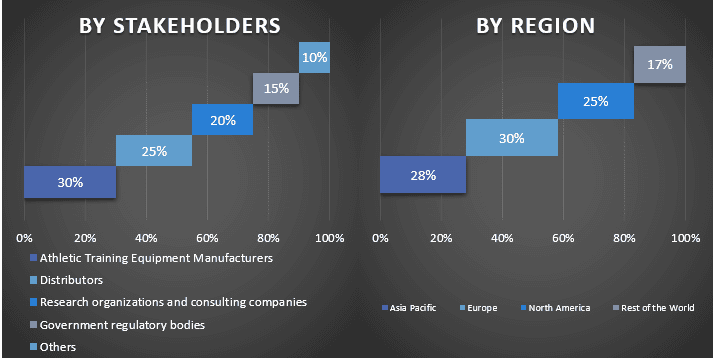
هندسة السوق
تم استخدام تقنية تثليث البيانات لإكمال تقدير السوق الإجمالي والوصول إلى أرقام إحصائية دقيقة لكل قطاع وفرعي من سوق معدات التدريب الرياضي العالمي. تم تقسيم البيانات إلى عدة قطاعات وقطاعات فرعية بعد دراسة المعايير والاتجاهات المختلفة في مجالات التطبيق ونوع المنتج والمواد والمستخدم النهائي في سوق معدات التدريب الرياضي العالمي.
الهدف الرئيسي من دراسة سوق معدات التدريب الرياضي العالمي
تم تحديد اتجاهات السوق الحالية والمستقبلية لسوق معدات التدريب الرياضي العالمي في الدراسة. يمكن للمستثمرين الحصول على رؤى استراتيجية لبناء تقديرهم للاستثمارات على التحليل النوعي والكمي الذي تم إجراؤه في الدراسة. حددت اتجاهات السوق الحالية والمستقبلية الجاذبية الإجمالية للسوق على المستوى الإقليمي، مما يوفر منصة للمشارك الصناعي لاستغلال السوق غير المستغلة للاستفادة كميزة المحرك الأول. تشمل الأهداف الكمية الأخرى للدراسات ما يلي:
- تحليل حجم السوق الحالي والمتوقع لسوق معدات التدريب الرياضي من حيث القيمة (بالدولار الأمريكي). أيضًا، قم بتحليل حجم السوق الحالي والمتوقع للقطاعات والقطاعات الفرعية المختلفة
- تشمل القطاعات في الدراسة مجالات النوع والجنس ونوع المشتري وقناة التوزيع.
- تحديد وتحليل الإطار التنظيمي لصناعة سوق معدات التدريب الرياضي.
- تحليل سلسلة القيمة المتضمنة مع وجود وسطاء مختلفين، جنبًا إلى جنب مع تحليل سلوكيات العملاء والمنافسين في الصناعة.
- تحليل حجم السوق الحالي والمتوقع لسوق معدات التدريب الرياضي للمنطقة الرئيسية.
- تشمل الدول الرئيسية في المناطق التي تمت دراستها في التقرير آسيا والمحيط الهادئ وأوروبا وأمريكا الشمالية وبقية العالم.
- ملفات تعريف الشركة لسوق معدات التدريب الرياضي واستراتيجيات النمو التي يتبناها اللاعبون في السوق للاستمرار في السوق سريعة النمو
- تحليل متعمق على المستوى الإقليمي للصناعة.
الأسئلة الشائعة الأسئلة الشائعة
س1: ما هو حجم السوق الحالي وإمكانات النمو لسوق معدات التدريب الرياضي العالمي؟
س2: ما هي العوامل الدافعة لنمو سوق معدات التدريب الرياضي العالمي؟
س3: أي قطاع لديه أكبر حصة في السوق العالمية لمعدات التدريب الرياضي حسب النوع؟
س4: ما هي التقنيات والاتجاهات الناشئة في سوق معدات التدريب الرياضي العالمي؟
س5: أي منطقة ستسيطر على سوق معدات التدريب الرياضي العالمي؟
س6: من هم اللاعبون الرئيسيون العاملون في السوق العالمية لمعدات التدريب الرياضي؟
ذات صلة التقارير
العملاء الذين اشتروا هذا المنتج اشتروا أيضًا










